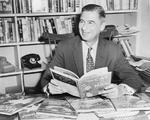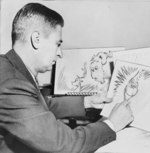Theodor Geisel
| Surname | Geisel |
| Given Name | Theodor |
| Born | 2 Mar 1904 |
| Died | 24 Sep 1991 |
| Country | United States |
| Category | Other |
| Gender | Male |
Contributor: Bryan Hiatt
ww2dbaseMost people know Theodor Seuss Geisel as Dr. Seuss, author of kid classics, among them The Cat in the Hat (1957), Green Eggs and Ham (1960), and There's a Wocket in My Pocket (1974).
ww2dbaseWhat readers of Dr. Seuss likely wouldn't know is this: in January 1941 after establishing himself as a cartoonist, Geisel began penning one-panel, political cartoons for a newspaper in New York called PM and did so until January 1943. Browsing the online archive at UC San Diego, it's clear that he was concerned about Germany's aggressive military actions in Europe, his countrymen's isolationist leanings, and after the Pearl Harbor attack, his country's continued internal bickering about the best way to fight the war.
ww2dbaseSeveral cartoons are illustrative of these tensions. First, a cartoon dated June 23, 1941 shows a typical Dr. Seuss bird (fat belly with a long neck), wearing an Uncle Sam hat relaxing with feet up and a drink on a side table, as the world is being shot up and shelled on all sides. One bullet even rips through the bird's tall hat and another through the "home sweet home" sign next to the chair. The caption reads:
'Up to now they've scored very few hitz,
So I'll sit on my canny
Old Star Spangled Fanny...'
And on it he sitz and he sitz."
ww2dbaseGeisel knew that the war would eventually come to the US, despite his government's perceived reluctance to act or the efforts of isolationist groups. The group America First (a group that espoused complete neutrality from the European war, including withholding aid—money and materiel) and Charles Lindberg (the famous pilot) were his frequent targets. A cartoon dated September 18, 1941 shows Lindberg atop a garbage truck labeled "Nazi Anti-Semite Stink Wagon", clad in a gas mask and shoveling garbage into the street with a caption that reads "Spreading the Lovely Goebbels Stuff," a reference to Nazi Propaganda Minister and a not so subtle dig at his patriotism.
ww2dbaseLindberg spoke at many of America First's rallies, and "[h]is approach was, in effect, more understanding of the Germans (without approving of what they did) and more skeptical of the Allies than the conventional view in the United States. Lindbergh saw a divided responsibility for the origins of the European war, rather than an assignment of the total blame to Hitler, Nazi Germany, and the Axis states." After December 7, 1941, America First disbanded. On December 8, a Geisel cartoon shows an ostrich (his symbol for American isolationism) being blown into the sky under the under the word "WAR," an I-told-you-so send off.
ww2dbaseGeisel's cartoons from Pearl Harbor until early 1943 are generally patriotic, urging readers to get behind the war effort but also to face the new realities of the day. Many of them dealt with America's own internal political and social wrangling on how to defeat the Axis and Geisel believed such problems only aided the enemy.
ww2dbaseOther cartoons highlighted domestic tensions of the time. In a cartoon dated February 13, 1942, Geisel shows a myriad of Japanese Americans, all drawn with stereotypical round eye glasses and buck teeth, lining up, from California to Washington state, to receive a brick of TNT from a Japanese "official." On top of a building is another man, looking glass to the eye, who is "waiting for the signal from home." The depiction is troubling, according University of Massachusetts History professor Richard H. Minear, who writes:
ww2dbaseA cartoon dated June 30, 1942 backs up Minear’s assertion, showing Uncle Sam telling a concert pianist (the war industry) to use both white and black keys (labor), the latter with cob webs in-between. More cartoons of the period decried other types of American racial prejudice, phony optimism, and overconfidence by those not fighting. It is a difficult to reconcile these conflicting images, as Minear asserts, especially if we tend to think of Dr. Seuss as a quirky artist and wordsmith only.
ww2dbaseHe also "served with Frank Capra's Signal Corps (U.S. Army) making training movies. It was here that he was introduced to the art of animation and developed a series of animated training films featuring a trainee called Private Snafu."
ww2dbaseGeisel's cartoons shone on a light on a time, just as America faced its own inner demons about intervention in Europe, the early stages of the war at home, and all its associated social, racial, and political underpinnings. These cartoons, as illuminating as they are on Geisel the artist, are not without warts.
ww2dbaseHe died in 1991.
ww2dbaseSources: Mandeville Special Collections Library at the University of California, San Diego, www.charleslindberg.com, Dr. Seuss National Memorial, Dr. Seuss Goes to War: The World War II Editorial Cartoons of Theodor Seuss Geisel, and the Springfield (Mass.) Library.
Last Major Revision: Apr 2005
Photographs
 |  |
Theodor Geisel Timeline
| 2 Mar 1904 | Theodor Geisel was born in Springfield, Massachusetts, United States. |
| 24 Sep 1991 | Theodor Geisel passed away. |
Please consider supporting us on Patreon. Even $1 per month will go a long way! Thank you. Please help us spread the word: Stay updated with WW2DB: |
Visitor Submitted Comments
12 Nov 2009 08:26:42 AM
you need to talk about Dr. Seuss being IN the army.
20 Mar 2011 12:04:13 PM
tell when he joined the war!!!!!!!!!!!!!!!!!!!!!!!!!!!!!!!!!!!!!!!!!!!!!!!!!!!!!!!!!!!!!!:( Other than that it SUCKED!!!!!!!!!!!!!!!!!!!!!!!!!!!!!!!!:(
8 Oct 2012 08:07:32 AM
it was all right got some information but it wasnt the best of all the sights ive seen.
6 Jan 2015 07:52:24 AM
Maybe talk about what he views of the war, and what he drew the political cartoons for
All visitor submitted comments are opinions of those making the submissions and do not reflect views of WW2DB.
» This is Ann: she's dying to meet you
- » 1,167 biographies
- » 337 events
- » 44,601 timeline entries
- » 1,243 ships
- » 350 aircraft models
- » 207 vehicle models
- » 376 weapon models
- » 123 historical documents
- » 261 facilities
- » 470 book reviews
- » 28,520 photos
- » 367 maps
Winston Churchill, on the RAF
Please consider supporting us on Patreon. Even $1 a month will go a long way. Thank you!
Or, please support us by purchasing some WW2DB merchandise at TeeSpring, Thank you!
20 Dec 2008 01:51:27 PM
I was wondering if someone could include what Dr. Seuss's views of war industry were.